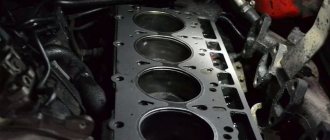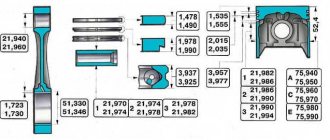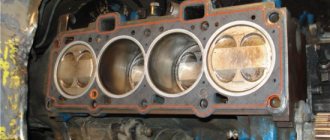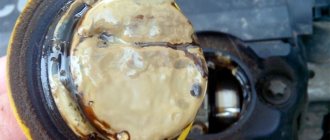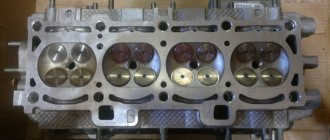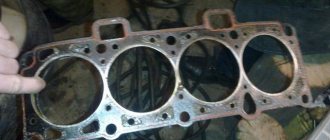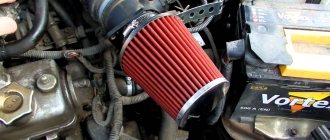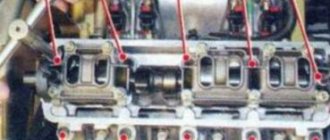Grinding the cylinder head is an operation that is performed during a major overhaul of the internal combustion engine, engine overhaul, etc. Also, the need to grind the head may arise when the so-called “iron” tuning of the internal combustion engine is carried out, changes and modifications are made to the engine design in order to boost the power unit, the engine compression ratio is increased by reducing the height of the head, etc.
As you know, the cylinder head (cylinder head) is one of the main components of the engine. The head of a modern power unit contains a timing belt, the head itself fits tightly to the cylinder block (BC) through the cylinder head gasket, part of the combustion chamber is made in the head housing, and the channels of the engine lubrication and cooling system also pass through. For this reason, for the best fit, it is necessary to grind the cylinder head; in parallel with grinding the cylinder head, in some cases the surface of the cylinder block is also grinded. Next we will talk about how the cylinder head is ground, as well as how to perform this operation yourself.
Read in this article
What's the result?
It is quite obvious that the further selection of the cylinder head gasket will also directly depend on the depth of grinding, not only in terms of materials of manufacture (for example, metal or reinforced paronite), but also in terms of thickness. This statement is also true if, after milling, there is a risk that the timing valves will be too long. In such a situation, the thickness removed during grinding is compensated by the increased thickness of the new gasket, installation of a double gasket, and also shortening of the valves.
Qualified work on checking for leaks, repairing cracks, boring and grinding the cylinder head or cylinder head allows you to obtain a tested and fully functional part, which, after installation on the car, will be the key to the further proper operation of the internal combustion engine. For example, a professionally repaired and correctly installed head will last for more than tens of thousands of kilometers, provided that general recommendations during operation and timely maintenance and repair of the engine are followed.
How to independently determine that the cylinder head gasket has burned out. Recommendations for pulling the cylinder head after replacement. Which gasket is better to choose?
Cylinder head grinding: why, when and who needs it?
The head is mounted on a flat surface, then a pattern is installed on its surface, which should fit as tightly as possible to the surface of the cylinder head. If there is a gap between the pattern and the surface, a probe is installed in it to measure the degree of curvature, after which a verdict regarding grinding is announced. In case of geometry violation. If for some reason the head is bent and does not pass the test with a template and feeler gauge, it is necessary to grind it.
If the head had defects such as cracks or other unacceptable damage that were eliminated by welding, then most likely the head was subject to local overheating, which resulted in corresponding deformations.
Lada 2109 8V on Dell'Orto DHLA 40 › Logbook › Milling the cylinder head plane
However, there are inserts of this type with a chip-breaker groove - this will significantly improve the surface quality! D125mm milling cutter, with PNUM inserts with a chipbreaker Close-up of the inserts, remember))) The surface quality is not very good.
A cutter with three plates without a chipbreaker. The same cylinder head after light finishing with 800-1200 grit sandpaper... You can get a roughness parameter of Ra 3.2) You can get a roughness of Ra 3.2++ if you remove 6 of the 8 wedges with plates. There are only 2 plates left and the result is a kind of flying cutter.
In this case, the feed should be less, and the speed of the cutter, on the contrary, should be greater than that of a cutter with all 8 plates. A kind of flying cutting head... The choice of alloys for these inserts is very small, T5K10 and T15K6 are more common... The latter option is preferable. Somewhat less common There are cutters with mechanical fastening of tetrahedral plates according to the same GOST.
Checking the quality of lapping
As already mentioned, only a professional will be able to see by eye how well the valves were ground in. But even they check the grinding of the plate with the seat using kerosene, gasoline or just diesel fuel. To do this, the cylinder head is installed strictly horizontally on a flat surface, and liquid is poured into the cylinders. If after 12 hours the kerosene level in one of the cylinders has decreased significantly, you will have to repeat the grinding of both valves again. If there are 4 valves in the cylinder, that is, 2 intake and 2 exhaust, then the grinding will need to be repeated on all 4.
There is an opinion that valve grinding should be done not only after 50,000-60,000 km, but also on new cars. It is clear that the procedure is not required on budget sedans or other ordinary cars. But it is mandatory on sports cars, since there, every kPa of compression, every horsepower plays a role. So, when preparing a sports car for racing, you cannot do without lapping the valves. And here the test is not only a visual or kerosene test, but also on the race track.
What are the pitfalls when processing the cylinder head plane?
If you are not using a specialized, but a universal milling machine, then in many types of milling machines, with large table strokes (when you drive the table from the far left point to the far right), when worn, or when gaps appear in the guides, a defect such as table collapse may appear . The table, under its own weight (and believe me, it weighs quite a lot), tilts slightly to the left in the extreme positions of the table's travel. Accordingly, the plane becomes not quite a plane, but a kind of arc. If this arc fits into a couple of three hundred square meters, there is nothing wrong with it. Mounting deformations will still be significantly greater and this couple of hundred square meters will not affect anything, which suggests that it is quite possible to use universal milling machines. However, if the machine is old, the guides are loose, then this couple of three hundred square meters can grow to one and a half to two dozen, but this is no longer good for anything. For this reason, you need to check the block head and monitor the quality of the equipment very, very carefully. Not every milling machine will create a plane. It may look perfect, but when you roll it with an indicator, you will see that our plane is not flat. This is such an ambush, guys.
What to use?
Such work involves the use of rough tools that are distinguished by almost jewelry precision - countersinks and cutters. Such tools with narrow specifications are used exclusively for engine repairs.
A selection of cutters for valve seats is used for recessing the required diameter sizes. Such actions make it possible to give the plate maximum closing density.
Countersinks are used in the same way when repairing valve seats. But there is one difference - the countersink is used not only on mechanical, but also on power tools.
Tool
If we are replacing valves with our own hands, be it a VAZ or another car, we must not miss such a nuance as the presence of a special tool. Here's what you'll need:
Sets: wrenches, sockets, screwdrivers for dismantling and installing machine elements.
Valve desiccant. It is needed to compress the springs in order to eliminate the cracks (locking elements).
Lapping tool. The valves require lapping to ensure compression. Purchasing a special device is not advisable; you can use a drill and a piece of hose.
The hose tightly connects the valve stem and the drill attachment and grinds in with translational movements. Then pour diesel fuel at the junction of the valve and the seat; if it does not leak, then the job is done efficiently.
Tool for removing oil seals. When replacing valves, you need to change the caps on the bushings, which will be quite difficult to do with your own hands. It is better to use a special puller.
There is another device - a micrometer. It will give an accurate measurement of the rod parameter and identify valve wear defects.
A key for fixing the crankshaft in order to adjust the correct operation of the timing belt.
It is advisable to have a torque wrench to tighten the bolts.
Consumables
In addition to valves, you will need:
- suitable sealing caps;
- cylinder head gasket;
- valve cover gasket;
- if necessary, sealant;
- cylinder head mounting bolts, sometimes it is possible to use old bolts;
- lapping paste or powder.
Countersinks and cutters for repairing valve seats – what to choose?
Replacing valve seats with your own hands requires the presence of not only a rough tool, but also an almost jewelry one - a roller cutter or a countersink. These highly specialized tools are used only for repairing internal combustion engines. A set of cutters for valve seats is used to grind out the desired shape of their internal diameter. This operation allows you to achieve a tight seal from the plate. In order to accurately process the valve seat, it is advisable to have a drawing of the mechanism at hand.
The cutter is made in the form of a metal cylinder, in which there is a hole and two or one conical surface; its angle can vary from 15 to 60 degrees. There are incisors on the surface of the cone. A set of countersinks for repairing valve seats is used in the same way as cutters, but there is one difference. The countersink can be used on mechanical and electrical tools.
Golf 2 engine repair video 10, we grind the head and my set of cutters
Valve seat blank
For all popular engines, valve seat blanks are offered, both standard sizes and repair ones, with an increased outer diameter. For rare engines, blanks must be ordered or made to order.
How the block head is polished
Let's start with the fact that skilled operations with the cylinder head and grinding the cylinder at home are not recommended, although this is possible and there are several ways. Now let's move on to the procedure itself, taking into account how it should be performed correctly. First of all, you need to check the plane of the cylinder head. This is done using a long steel ruler, as well as feeler gauges (feelers can be used to adjust the thermal clearance of valves). An important condition is that the ruler must be smooth, equal in thickness, without bending or defects. The specified ruler must be applied diagonally to the lower plane, after which a suitable probe is inserted into the gaps that form between the plane of the head and the applied ruler. These actions are performed one by one.
Let us add that this method of measuring using a ruler is not highly accurate, but it allows you to quickly check the plane of the cylinder head with your own hands right in the garage. If the cylinder head is deformed, then feeler gauges and a ruler help to clearly identify defects, as well as assess the severity of the problem. It should also be noted that in the event of a burnout of the gasket, the most obvious deformations of the mating surface will be precisely in the place or near the area where the gasket was pierced. Carbon deposits on the pistons in the cylinders located near the puncture site can also be considered an indirect sign.
Let's move on. If defects are found, then the next step is to check the head for cracks. In the garage, they usually use paint or dyes with similar properties, which cover the body of the cylinder head, which has been previously washed and free of dirt. Then the dye is removed from the surface, after which problem areas are identified using the remnants of the dye trapped in the cracks. The method is quite simple, but microcracks or internal damage to the body cannot be determined using paint. To more accurately diagnose the tightness of the housing and check for cracking of internal surfaces, you need to contact specialists or have suitable equipment on hand. The cylinder head needs to be heated, after which the head is placed in a special bath of water. Without going into details, microcracks appear due to air bubbles that come out as a result of the supply of pressurized air to the head housing. Then the cylinder head crack (if any) should be repaired, after which the cylinder head can be ground.
The process of grinding the block head with your own hands is possible if you have a milling and grinding machine or experience in performing similar work yourself using a grinding wheel, sandpaper, etc. In other words, it is better to trust grinding operations only to trusted and experienced specialists. If you decide to repair the engine yourself, then you need to pay special attention to certain subtleties that are associated with grinding the head.
During milling, the most important parameter is the permissible grinding thickness. To put it simply, you need to know how much metal can be removed as much as possible from the surface of a particular cylinder head. Information about the depth to which the head can be ground should be contained in technical literature, repair manuals and additional sources in relation to a specific type and model of internal combustion engine. The engine manufacturer must indicate this parameter for repair, after which the unit will operate normally. If the plane defects are too serious, that is, deep milling to eliminate them may require removing the entire allowable margin and exceeding the value recommended by the manufacturer, then in this case it may be necessary to replace the cylinder head.
Instructions
Grinding machine
It is unlikely that you will be able to carry out this process yourself, since, as you can see in the video, this requires a milling machine. However, we will still introduce you to the technology of this process so that you have an idea about it.
When the cylinder head is dismantled from the engine to the machine, the first question that arises concerns the thickness of the milling. In this case, you should familiarize yourself with the maximum repair depth of surface milling, and this is stated in the service book for your car. If you follow all the nuances of this issue, then you will not have problems with the further functioning of the motor. In addition, when you find out the required thickness, you should definitely tell the specialist who will do the milling on the machine, so that he can select the gasket of the required thickness.
We also recommend replacing the valve seals and wiping the valves themselves. It is advisable to do this before starting work so that you do not have to wipe the burnt elements afterwards. It should also be noted that this will increase the engine power, and it is not at all necessary to buy new elements; it is quite possible to use old ones. Of course, if their condition is not sad.
Photo 1. Defects on the inside of the cylinder head before milling
Photo 2. The internal plane of the cylinder head after grinding without defects
It is also necessary to clean the inner surface of the cylinder head from gasket residues. This is done using a regular knife or sharpening stone. Please note that the movements you make to remove any remaining gasket should be in a zero or figure eight shape. They should also be smooth. When all the residue is removed, you will be able to see how warped the head is, so you need to process the cylinder head until all the uneven areas are corrected. As a result, you should get the most even and mirror-like plane of the assembly as possible, which will ensure the most maximum compaction.
As you understand, this process is unlikely to be carried out properly at home, so we advise you to seek help from professionals.
Main Reasons for Grinding
The first and main condition for starting grinding is the uneven installation of the cylinder head gasket and its subsequent burnout. The reasons for this appearance may be overheating of the engine, the ingress of small mechanical parts, or water, which, if detonated, can damage the gasket.
The gasket itself is not so simple; it consists of several layers and a frame; it is made from perforated sheet steel. The main purpose is to seal the joints of two parts. Boiling of the engine, bubbles in the cooling system, change in oil color are the first indicators that the cylinder head gasket has become unusable.
It will be useful: What is an engine stroker?
Engine tuning is often considered the second reason for grinding. A sign of this is a decrease in engine power when you press the accelerator pedal, or simply the engine stops pulling. I would like to say right away that the process is not easy and will require the expenditure of both time and money.
